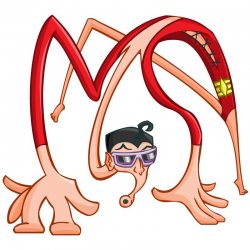- Sep 22, 2013
- 4,956
- 250
- 85
When we read a comic strip about a flexible superhero such as Plastic Man (DC Comics) or a deformed super-villain such as Clayface (DC Comics), we subconsciously think about the genotypes/phenotypes that give rise to the human physique and how adaptation is related to body appearance.
The human brain sends all kinds of electrical signals/impulses to the different parts of the body and helps coordinate actions and reflexes. The human brain neurotransmitter (a brain chemical that gauges responses and memory categories) serotonin affects how the mind processes and creates dream-imagery during R.E.M. sleep (the period during sleep when dreams are richest). Serotonin, therefore, acts as a kind of 'messenger' for memory/creativity.
How we dream impacts how we view ourselves and our ability to interact with our environments.
When we entertain ourselves with movies/cartoons about Plastic Man or Clayface, we are implicitly engaging in a social negotiation about the human perspective on adaptation and transformation. Since transformation is so important to anticipation and self-awareness, deformities in the brain that affect serotonin levels, for example, could seriously affect how we are able to generally coordinate brain signals with overall mental happiness.
The modern world is gauged by networking sophistication (e.g., eTrade, Wall Street, etc.) and transit technologies (e.g., smartphones, super-trains, etc.). How we view society as 'grid-savvy' affects how we view the overall coordination of civilization. When civilization goes awry (e.g., terrorism), we feel that our dreams have become discoordinated and that we are literally destroying ourselves.
Understanding the phenotype of radiation survivors (e.g., Hiroshima), for example, illuminates how our species adapts in the brain/body/mind to undesirable shock and helps scientists understand the nature and scope of 'macro-deformities.'
Radiation Survivors
Trajectories of Anatomic Brain Development

The human brain sends all kinds of electrical signals/impulses to the different parts of the body and helps coordinate actions and reflexes. The human brain neurotransmitter (a brain chemical that gauges responses and memory categories) serotonin affects how the mind processes and creates dream-imagery during R.E.M. sleep (the period during sleep when dreams are richest). Serotonin, therefore, acts as a kind of 'messenger' for memory/creativity.
How we dream impacts how we view ourselves and our ability to interact with our environments.
When we entertain ourselves with movies/cartoons about Plastic Man or Clayface, we are implicitly engaging in a social negotiation about the human perspective on adaptation and transformation. Since transformation is so important to anticipation and self-awareness, deformities in the brain that affect serotonin levels, for example, could seriously affect how we are able to generally coordinate brain signals with overall mental happiness.
The modern world is gauged by networking sophistication (e.g., eTrade, Wall Street, etc.) and transit technologies (e.g., smartphones, super-trains, etc.). How we view society as 'grid-savvy' affects how we view the overall coordination of civilization. When civilization goes awry (e.g., terrorism), we feel that our dreams have become discoordinated and that we are literally destroying ourselves.
Understanding the phenotype of radiation survivors (e.g., Hiroshima), for example, illuminates how our species adapts in the brain/body/mind to undesirable shock and helps scientists understand the nature and scope of 'macro-deformities.'
Radiation Survivors
Trajectories of Anatomic Brain Development

